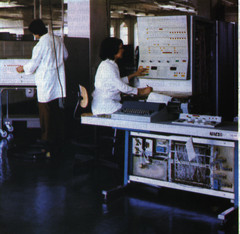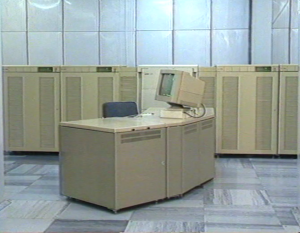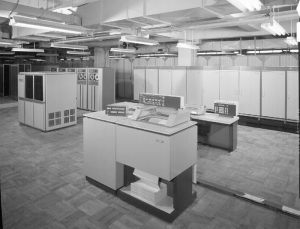ES-1020 COMPUTER
Developers: The chief designer – Przhiyalkovsky V. V. Deputy of the chief designer – Smirnov G. D. Main developers: Maltsev N. A., Volkov L.I., Chalaydyuk M. F., Musclemen V.P., Astsaturov R. M.

ЕС 1020 ЗИТ-София настройка
The organization – the developer – NIIEVM Minsk. MRP USSR
Мanufacturer’s – Minsk COMPUTER plant “Ordzhonikidze”, Brest electromechanical plant, the Bulgarian “ZIT” plant – Sofia.
Year of the end of development – 1971.
Year of the beginning of release – 1971.
Year of cessation of production – 1975.
Scope: Computer centers of the enterprises, associations, departments. Scientific and technical and economical calculations.
Number of the released computers:
Minsk plant-595 of piece.
The Brest plant – 60 pieces.
Bulgarian “ZIT” plant – about 100 pieces.
Structure of the COMPUTER:
Architecture of the EU of EVM-1(ЕС ЭВМ-1).
A digit grid – 8 categories.
A set of teams – 144 teams of a standard set of teams of the EU of EVM-1.
The volume of the operational STORAGE on ferrite cores – 64 – 256 Kb.
Means of a direct control for creation of two-machine complexes.
The universal interface for communication with external devices.
Three selector channels.
Stores on replaceable magnetic disks with a capacity of 7.25 Mb.
Stores on magnetic tapes with a density of record of 32 pulse on mm.

Computing center – ZIT
ES-1020-B processor
Element base – integrated chips of a series 155 (Logician-2). Eight first types of chips of small extent of integration.
Design – three standard cases of the EU of EVM-1, a processor case, a food case, a case of the ferrite STORAGE. in each case 2 rotary frames with two panels everyone. Case sizes: 1200х750х1600 mm. Field-replaceable unit (FRU) 140х150 mm in size. (standard FRU EU of the COMPUTER) Air cooling by means of standard fans of the EU of the COMPUTER. Food from a set of standard power units of the EU of the COMPUTER.
Technology: Bilateral printed-circuit boards FRU – were produced by method of through metallization. Installation of panels was made by a price markup method. The mechanized preparation and installation of elements on FRU payment. Group soldering FRU wave. Semi-automatic installation of panels and the automated control of installation of panels of frames, cases. A number of the bench equipment allowing to mechanize operations.
Software. The mashines are delivered with the disk operating system (DOS) including except the operating programs providing simultaneous passing of three working programs, translators from the Assembler languages, RPG, the Fortran-4, Kobol, PL-1, and also the system serving programs and system of test control of devices was delivered.
Technical and operational characteristics.
Productivity – 20 thousand operations per second on the mix Gibson-3.
The space occupied by the main set – 80-100 sq.m.
Working temperature of air – 5-40 °C.
The power consumed by the processor – 4.5 kVA.
Features of the COMPUTER. ES-1020-the first COMPUTER of Uniform system of the COMPUTER of the countries of the socialist commonwealth realizing completely the principles of work of the EU of the COMPUTER. The first COMPUTER which provided full information and program compatibility with the most widespread western COMPUTERS of general purpose.
Literature
Przhiyalkovsky V. V., Smirnov G. D., Maltsev N. A., Astsaturov R. M., Musclemen V.P., Golovan A.K. “The electronic ES-1020 computer”, Moscow, “Statistics” of 1975.
9 copyright certificates, the main thing – “System of data processing” of ampere-second are introduced. The USSR No. 433404 from 30. 02. 1974. Authors – Przhiyalkovsky V. V. Smirnov G. D. Maltsev N. A., etc.






